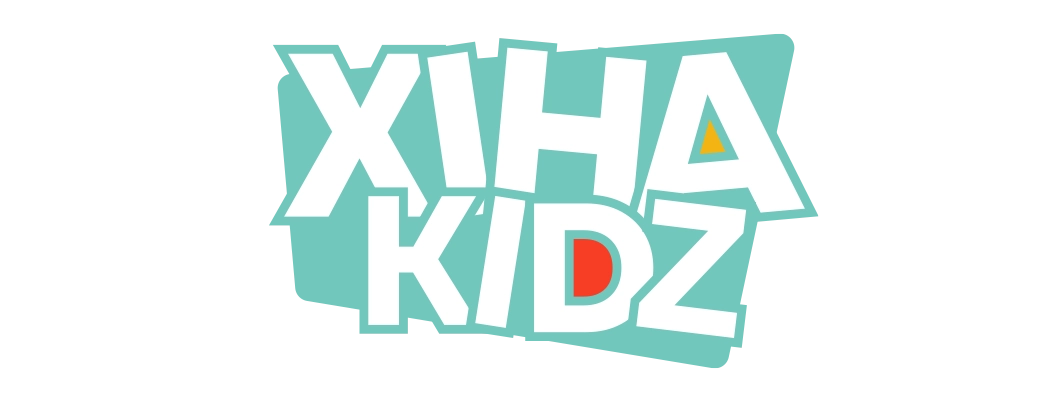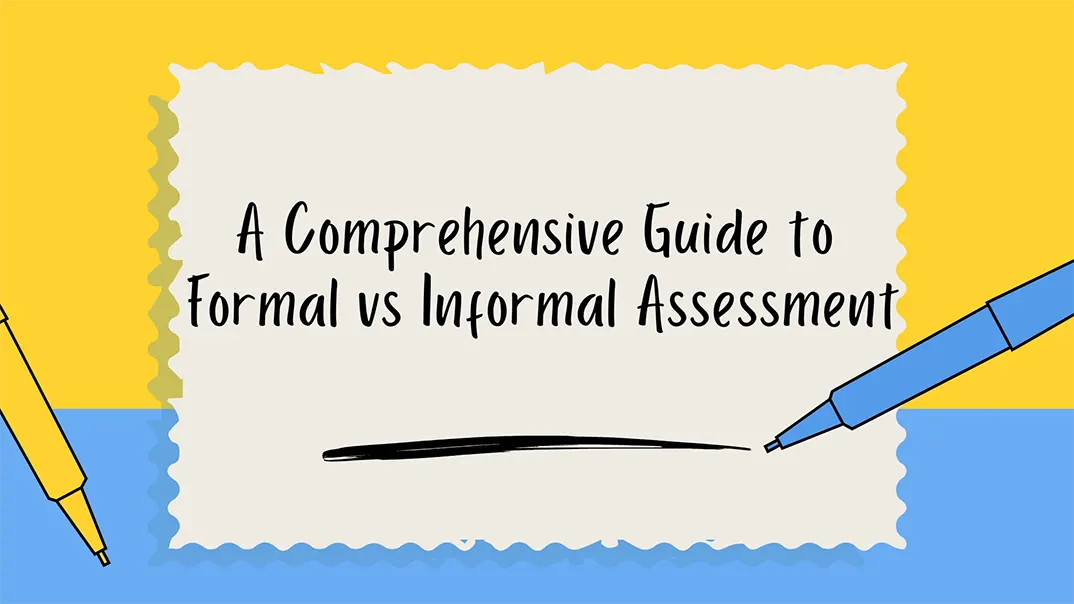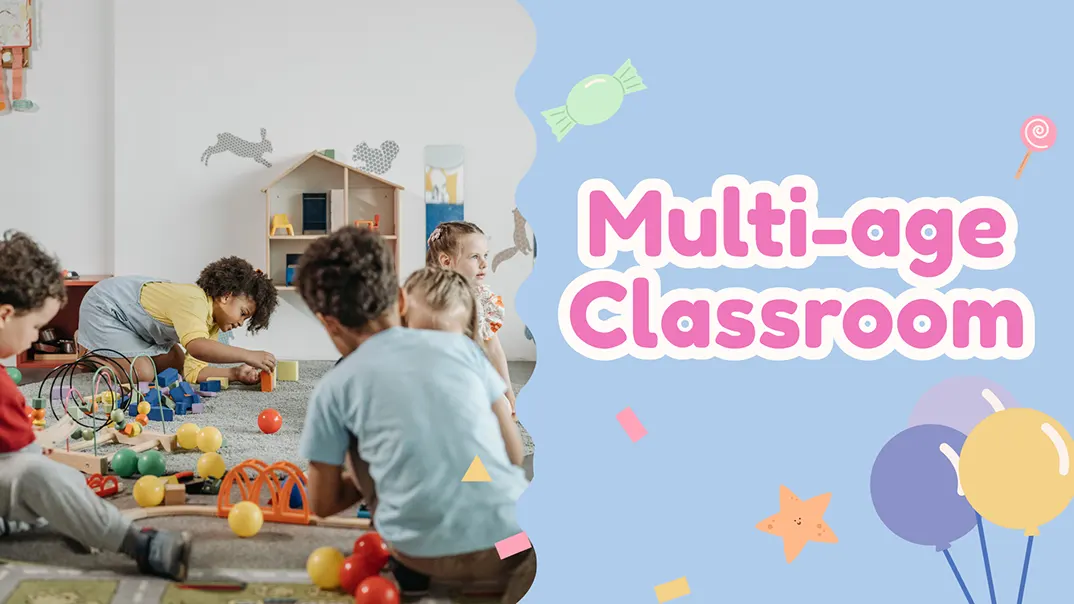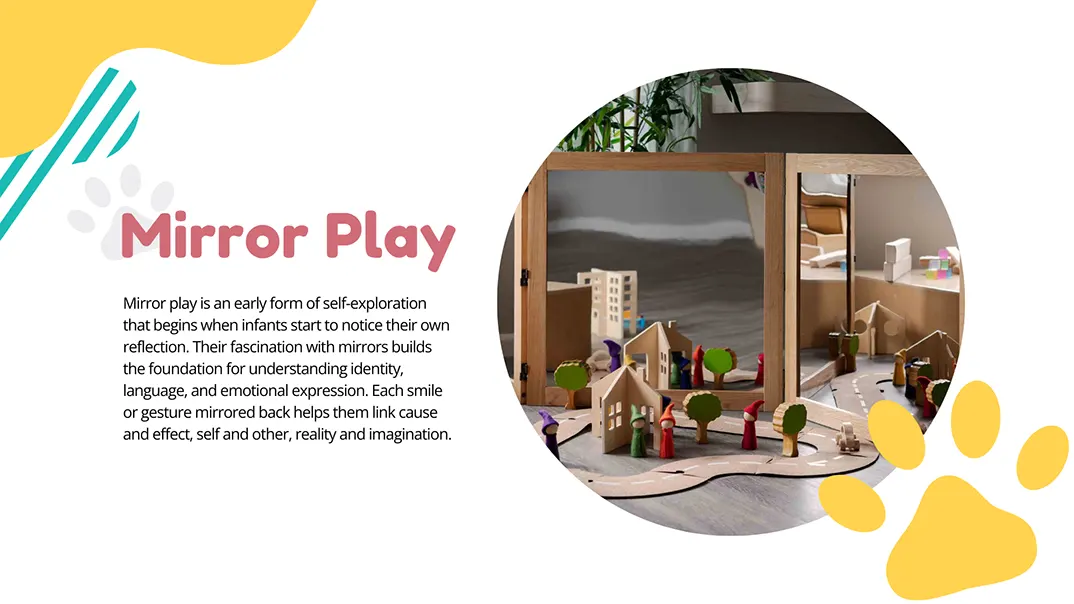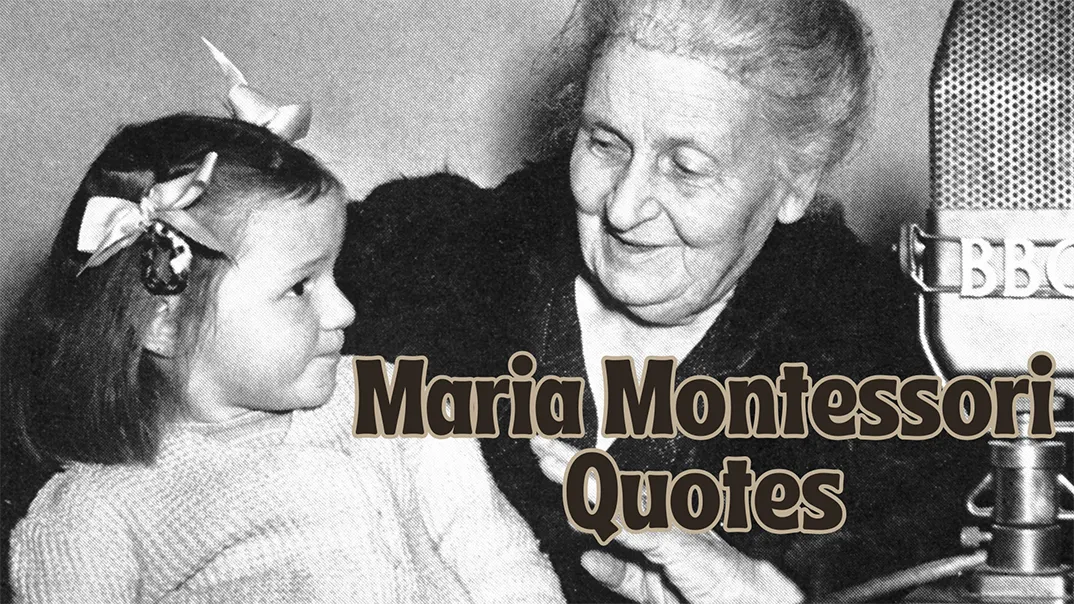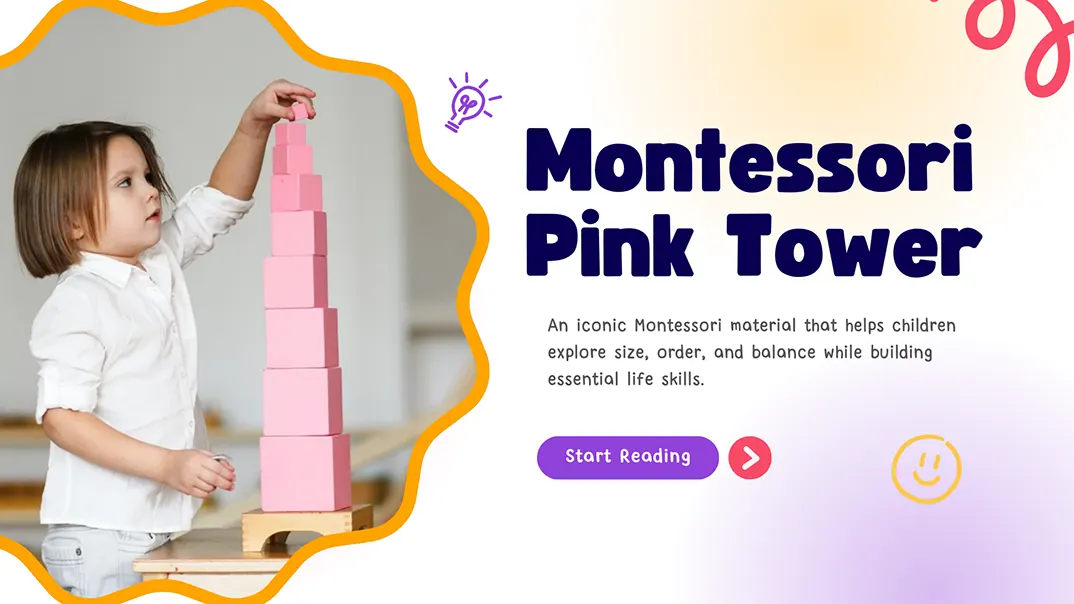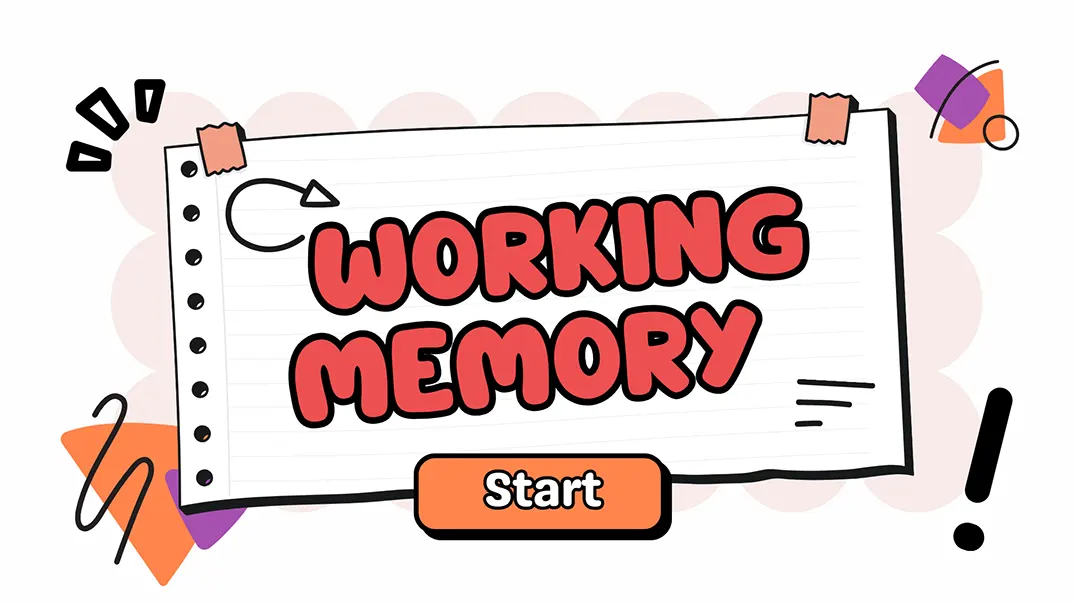In the world of early childhood education, assessment plays a vital role. But do you know which method best suits your classroom or child? Should you rely on test scores or trust your daily classroom observations? The debate between formal vs informal assessment leaves many educators and parents unsure of how to track and support a child’s development appropriately.
Understanding the contrast between formal vs informal assessment is the first step to making confident, informed choices. Formal assessment refers to structured, standardized methods such as written tests, quizzes, or developmental checklists designed to measure specific learning outcomes. These are often scored and used for reporting progress. In contrast, informal assessment involves unstructured or semi-structured observations, conversations, and performance tasks used to gather insights into a child’s learning in real time.
In this guide, we’ll delve into the practical differences between formal vs informal assessment, showing you when and how to use them effectively in early childhood settings. If you’re ready to elevate your teaching strategies and more effectively support every learner, keep reading.
Introduction to Assessment in Education
Educational assessment refers to the systematic process of documenting and using empirical data to measure knowledge, skills, attitudes, and beliefs. It provides educators with valuable insights into what students understand, how they think, and where they may need more support. Whether assessing academic performance, social-emotional growth, or developmental milestones, assessments are foundational tools in every สภาพแวดล้อมการเรียนรู้.

In early childhood education, assessment is not just about grades or scores—it’s about gaining a deep understanding of each child’s unique learning journey. Both formal vs informal assessment methods serve as lenses through which teachers observe and guide this journey with intention and responsiveness.
The primary purpose of assessment is to inform instruction. It helps educators tailor their teaching strategies to meet each child’s developmental needs and learning style. Through assessment, teachers can identify learning gaps, recognize strengths, and plan interventions that foster growth. Assessments also serve accountability purposes—providing data for educators, administrators, and parents to evaluate the effectiveness of programs or curricula.
What is a Formal Assessment in Education?
A formal assessment is a systematic and pre-planned method used to evaluate student learning through standardized tools and criteria. It is often designed to be objective, measurable, and replicable across various settings. In the context of formal vs informal assessment, formal methods typically generate quantifiable results that can be compared across groups of students, schools, or even districts.
In early childhood education, while formal assessments are used less frequently than in later grades, they still play a vital role in identifying learning milestones, developmental delays, and school readiness. These assessments are carefully designed, validated, and often externally administered or reviewed to ensure consistency and accuracy.

Characteristics of Formal Assessment
Formal assessment is a structured and standardized method of evaluating a child’s knowledge, skills, or development. It is designed to produce quantifiable data and is typically conducted under controlled conditions. Below are the key characteristics that define formal assessment in early childhood education:
- Standardization
Formal assessments follow a consistent set of procedures, questions, and scoring guidelines. Every child is assessed using the same tools and conditions, ensuring fairness and comparability across individuals or groups. - Objective Scoring
Unlike informal observations, formal assessments use pre-determined scoring systems, such as answer keys or developmental rating scales. This allows for objective evaluation, minimizing personal bias from the assessor. - Planned and Scheduled
These assessments are administered at specific times during the school year, often at the beginning, middle, or end of a term. This scheduled approach supports long-term curriculum planning and progress tracking. - Data-Driven Result
Formal assessment results are typically expressed in numerical form—percentages, scores, levels, or grades. These results can be analyzed statistically and used to inform curriculum decisions or compare student performance to benchmarks. - External Use and Reporting
The data collected from formal assessments is often shared with administrators, policymakers, or parents. It plays a significant role in school accountability, funding decisions, and program evaluations. - Limited Flexibility
Due to their standardized nature, formal assessments may not fully capture individual learning styles, cultural backgrounds, or real-time learning progress. They are often best suited for evaluating specific academic or developmental benchmarks.
Formal Assessment Examples
Formal assessments are designed to measure student performance against established standards or learning objectives. In early childhood education, they are typically used to evaluate developmental milestones, academic readiness, or skill acquisition. Below are several common examples of formal assessment:
- Standardized Tests
Professionally designed assessments are administered under controlled conditions to evaluate skills like language, cognition, or school readiness. Results are compared to national or regional norms. - Developmental Checklists
Structured tools are used to measure progress in physical, cognitive, and emotional milestones. Teachers’ scores are based on observable, pre-defined indicators. - Criterion-Referenced Tests
Assessments that measure a child’s performance against specific learning objectives (e.g., identifying colors, counting to 20, or recognizing letters). - Written Quizzes and Worksheets
Structured activities, such as matching games or fill-in-the-blanks, are scored using consistent criteria to measure knowledge or skills. - Rubric-Based Portfolio Assessments
When children’s work samples are evaluated using standardized rubrics with clear benchmarks, the process becomes a formal assessment method. - Midterm and Final Assessments
These scheduled evaluations occur at the middle and end of a term. In early education, they may include structured tasks such as matching, sorting, or short written exercises designed to assess cumulative learning over time. The content and format remain consistent for all students, and results are used to track long-term progress.
What is Informal Assessment in Education?
Informal assessment refers to non-standardized, flexible methods that educators use to monitor and understand student learning in real time. Unlike formal assessments, informal approaches are often unplanned, observational, and embedded within daily classroom activities. In the broader discussion of formal vs informal assessment, informal strategies are valued for their authenticity and responsiveness. Informal methods provide a more holistic and contextual view of a child’s growth, behavior, and learning style, making them especially valuable in early childhood education.
These assessments allow teachers to gather immediate insights without interrupting the learning process. Instead of producing numerical scores, informal assessments help educators adapt instruction on the fly, identify learning interests, and build stronger relationships with children through continuous interaction.

Characteristics of Informal Assessment
Informal assessment is a responsive, observational approach that allows educators to understand children’s learning in authentic contexts. It doesn’t rely on formal testing environments but instead takes place organically within daily routines, activities, and interactions. Key characteristics of informal assessment include:
- Unstructured and Flexible
Fixed formats or rigid schedules do not bind informal assessments. Educators can adjust their approach based on the child’s needs, activity type, or learning environment. - Observation-Based
Teachers gather information by watching how children interact with materials, peers, and tasks. These insights help form a deeper understanding of developmental progress. - ฝังอยู่ในกิจกรรมประจำวัน
Informal assessments occur naturally during classroom routines, such as storytime, play, or art, without disrupting the learning flow. - Immediate and Ongoing
Unlike formal testing, informal assessment provides continuous feedback. Teachers respond in real time to support the child’s learning as it unfolds. - Personalized and Contextual
The focus is on the individual child—how they learn, what strategies they use, and how they apply knowledge in different situations. - No Formal Grading or Scoring
Rather than assigning numerical scores or grades, educators may take anecdotal notes or use checklists for reflection and documentation. - Low Pressure for Children
Informal assessments create a stress-free environment. Since children are often unaware that they are being assessed, their responses and behaviors are more natural and authentic. - Promotes Teacher–Child Interaction
Teachers use open-ended questions and casual dialogue to explore a child’s thinking, encouraging both relationship building and deeper cognitive engagement. - Flexible Documentation Methods
Notes, audio clips, annotated work samples, or photos can all be used to record informal assessment data, enabling a more holistic view of learning over time.
Informal Assessment Examples
Informal assessments come in many forms and are woven seamlessly into the daily fabric of classroom life. They allow educators to gather meaningful insights about a child’s development without disrupting the flow of learning. Here are some of the most commonly used and practical examples of informal assessment:
- บันทึกเรื่องราวโดยย่อ: Teachers take brief, descriptive notes about children’s behavior, skills, or interactions during play and learning.
- Checklists and Rubrics: Used to monitor developmental milestones or behavioral patterns over time.
- Work Samples and Portfolios: Collections of children’s drawings, writings, or projects that show growth and creativity.
- Play-Based Observation: Watching how children solve problems, interact, and express themselves during play.
- Conversations and Interviews: Informal chats or guided questions to assess understanding or emotional well-being.
- Learning Stories: Narrative observations that connect learning to specific events or experiences.
- Peer and Self-Assessments: Allowing children to reflect on their own or others’ work, promoting metacognition.
Advantages and Disadvantages of Formal and Informal Assessment
In early childhood education, both formal and informal assessments offer valuable insights into children’s learning and development. However, each method comes with distinct strengths and limitations. Understanding these aspects helps educators make informed choices when designing a balanced assessment strategy.
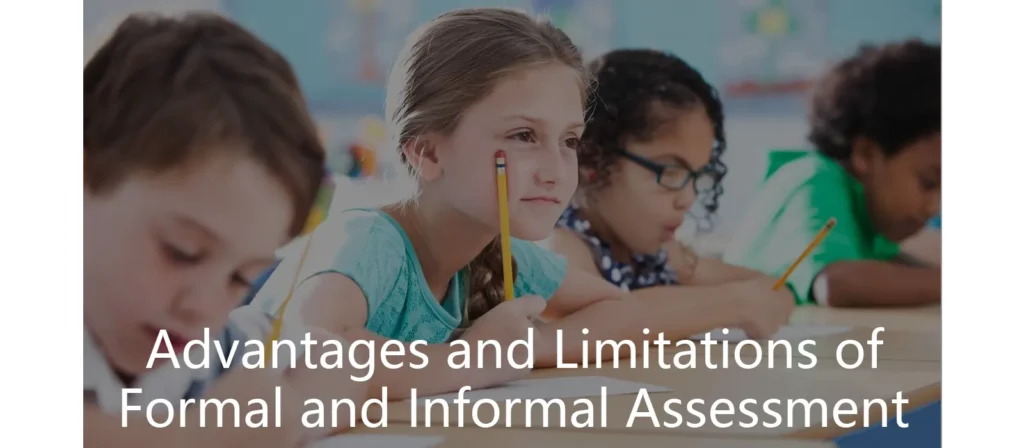
Advantages and Disadvantages of Formal Assessment
Formal assessment plays a pivotal role in structured educational settings, especially in early childhood programs where tracking developmental milestones and learning outcomes is critical. Understanding both the benefits and drawbacks of formal methods is essential in the broader context of formal vs informal assessment.
Advantages:
- Standardized and Objective
Formal assessments follow consistent procedures and scoring systems, ensuring that each child is evaluated under the same conditions. This reduces bias and allows for fair comparisons across students or groups. - Clear, Measurable Results
Scores, percentages, or proficiency levels provide quantifiable data that can be used to track a child’s progress over time or evaluate whether they are meeting curriculum standards. - Alignment with Educational Benchmarks
Formal tests are typically designed to reflect national or local curriculum objectives, helping educators assess how well students are grasping required content. - Useful for Documentation and Reporting
Formal assessment results are easy to record and communicate, whether for parent-teacher conferences, school accountability, or administrative review. - Efficient for Group Assessment
Structured tools allow teachers to assess multiple students simultaneously, saving time and ensuring uniform evaluation in larger classrooms.
Disadvantages:
- Limited Scope of Learning
One notable drawback of formal assessments is their often narrow focus. They may concentrate heavily on academic outcomes such as numeracy and literacy while neglecting critical areas like creativity, emotional intelligence, or social development, key components in early childhood education. - Stress and Anxiety
Children, particularly in preschool or early elementary years, may experience anxiety or pressure when subjected to formal testing environments. This stress can distort results and reduce the reliability of the assessment, especially if the child’s performance does not reflect their typical abilities. - Cultural and Language Bias
Formal assessments may unintentionally favor specific linguistic or cultural backgrounds, disadvantaging children from diverse communities. Such biases can lead to misinterpretation of a child’s abilities or needs, skewing educational planning and intervention. - Overreliance on Scores
In the formal vs informal assessment debate, a major criticism of formal tools is the overemphasis on numbers. Teachers and parents may focus more on scores rather than the holistic development of the child, potentially leading to rigid teaching methods or reduced attention to social and emotional growth.
Advantages and Disadvantages of Informal Assessment
Informal assessment is a dynamic and flexible approach to evaluating young children’s learning and development. In the broader comparison of formal vs informal assessment, informal methods offer a more personalized and ongoing view of a child’s growth, often capturing what formal tools may miss.

Advantages:
- Holistic Understanding of the Child
Informal assessment allows educators to observe children in natural settings during their daily routines, play, and social interactions. This provides a more complete picture of the child’s abilities, interests, and personality—elements often overlooked in formal testing. - Reduces Pressure on Children
Without the structure and expectations of traditional testing, children tend to feel more at ease during informal assessments. This relaxed environment helps them demonstrate their true abilities and reduces performance anxiety, making the results more authentic and meaningful. - Encourages Teacher Reflection and Responsiveness
Through techniques like anecdotal records, learning stories, and portfolio documentation, informal assessment encourages educators to reflect on their teaching and adapt their strategies to better support individual learning styles. It promotes a responsive teaching approach based on real-time observations. - Promotes Family Involvement
Informal assessments are often shared with families in narrative form or through examples of a child’s work, making it easier for parents to understand and engage in their child’s learning process. This fosters stronger home-school partnerships and supports consistency in developmental support.
Disadvantages:
- Lack of Standardization
A common criticism in the formal vs informal assessment comparison is that informal assessments lack consistency. Without standardized procedures, results can vary based on the observer’s perspective or context, leading to subjective interpretations. - Difficult to Compare Across Students
Because informal assessments are individualized and context-specific, it becomes challenging to compare results across different children or classrooms. This can pose problems for broader evaluations or policy-making. - Time-Consuming
Conducting and documenting informal assessments requires significant time and effort. Teachers must observe, record, and interpret behavior regularly, which can be demanding in busy classroom environments. - May Be Viewed as Less Credible
Some stakeholders, such as administrators or policymakers, may not consider informal assessments as reliable or valid as formal ones. This perception can affect funding, placement decisions, or policy development, even when informal methods provide rich, contextual insights.
ค้นพบผลิตภัณฑ์ทั้งหมดของเรา
เข้าถึงแค็ตตาล็อกที่ครอบคลุมของเราซึ่งมีเฟอร์นิเจอร์คุณภาพเยี่ยมและอุปกรณ์การเล่นสำหรับโรงเรียนอนุบาลและโรงเรียน
Differences Between Formal and Informal Assessments
When evaluating early childhood learners, educators often hesitate between formal and informal assessment methods. While both play essential roles in early childhood education, they differ significantly in structure, purpose, and application. Understanding these differences helps educators create a well-rounded approach to tracking developmental progress. Here are the key differences between formal vs informal assessment:

1. Structure and Standardization: Formal vs Informal Assessment
- Formal Assessment:
Formal assessments are highly structured and follow a consistent format for all students. They include preset instructions, time limits, and scoring criteria, leaving little room for variation. This standardization ensures reliability and comparability across groups. - Informal Assessment:
Informal assessments are unstructured or semi-structured. Teachers assess students through casual observation, conversation, or activities embedded in daily routines. There’s no fixed format, making it adaptable to each learner’s needs and classroom context.
2. Purpose of Assessment: Formal vs Informal Assessment
- Formal Assessment:
The purpose of formal assessments is to evaluate learning outcomes in a way that is measurable and reportable. These assessments often serve administrative or policy-related goals, such as determining whether a child meets developmental benchmarks or qualifies for specialized services. They also help measure the effectiveness of educational programs through quantitative data. - Informal Assessment:
Informal assessments serve primarily as instructional tools. Teachers use them to understand a child’s learning process better, guide immediate teaching decisions, and provide personalized feedback. The goal is not to grade performance, but to enhance the learning experience and respond to children’s needs in real time. In the formal vs informal assessment framework, informal tools are valued for their instructional relevance rather than administrative utility.
3. Frequency: Formal vs Informal Assessment
- Formal Assessment:
Formal assessments are usually administered at fixed intervals—weekly, quarterly, or annually. This might include unit tests, midterms, or annual standardized screenings. Their scheduled nature means they provide snapshots of learning at specific points in time, which can help track progress over more extended periods. - Informal Assessment:
Informal assessments are continuous and embedded in everyday interactions. A teacher might assess a child’s counting skills during snack time or observe language development during story time. These frequent, real-time insights allow educators to respond immediately to a child’s progress or struggles.
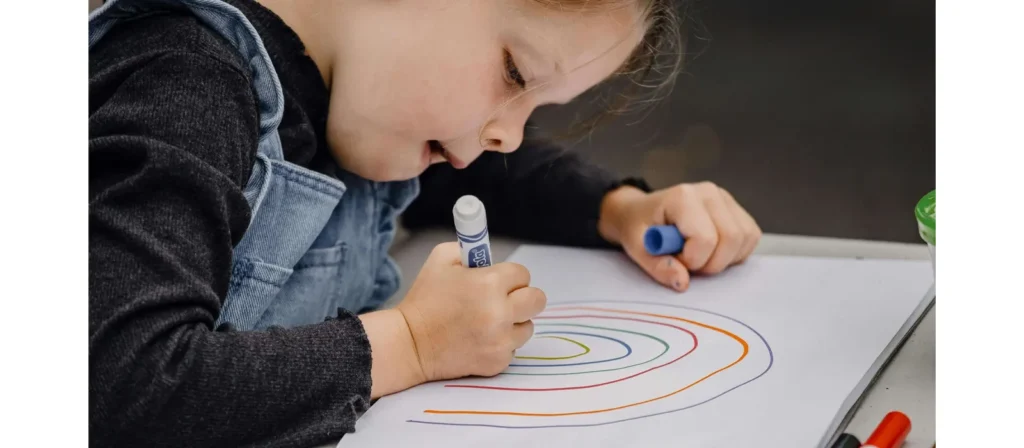
4. When to Use: Formal vs Informal Assessment
- Formal Assessment:
Formal assessments are best suited for situations that require measurable outcomes, such as identifying learning gaps, determining eligibility for intervention programs, or aligning student performance with curriculum standards. They are also essential for program evaluation, reporting to stakeholders, or meeting institutional requirements. - Informal Assessment:
Informal methods are ideal for everyday use in the classroom. Teachers use them to check for understanding, observe social-emotional development, and make timely instructional decisions. They work particularly well in early childhood education, where learning is fluid and individualized, and where educators benefit from ongoing insights rather than fixed data points.
5. Scope: Formal vs Informal Assessment
- Formal Assessment:
The scope of formal assessments is typically narrow and focused on specific content areas or developmental benchmarks. They are designed to evaluate targeted skills, such as literacy, numeracy, or cognitive functioning, within a defined framework. - Informal Assessment:
Informal assessments allow for a broader view of the child’s development. They capture learning across multiple domains—social, emotional, physical, and cognitive—often simultaneously. Because they happen in real-life contexts, they reveal not only what a child knows but also how they apply it in different situations.
6. Flexibility: Formal vs Informal Assessment
- Formal Assessment:
These assessments offer little to no flexibility. They follow rigid procedures that must be applied uniformly to all participants. Any deviation could compromise the reliability or validity of the results, making them less adaptable to individual learning differences. - Informal Assessment:
In contrast, informal assessments are highly adaptable. Educators can adjust their methods based on the child’s mood, interests, or responses. This flexibility makes them well-suited for inclusive and child-centered classrooms, where personalizing instruction is key to student success.
7. Grading System: Formal vs Informal Assessment
- Formal Assessment:
Formal assessments typically result in a numeric or letter grade, percentage score, or percentile ranking. These outcomes are used for report cards, academic records, or determining progression. The grading is based on a standardized rubric or answer key, making results easy to quantify and compare. - Informal Assessment:
Informal assessments usually do not involve traditional grades. Instead, they offer descriptive feedback that helps teachers understand a child’s thinking process or developmental stage. Observations may be documented through notes or learning stories, focusing more on growth and effort than on right or wrong answers.
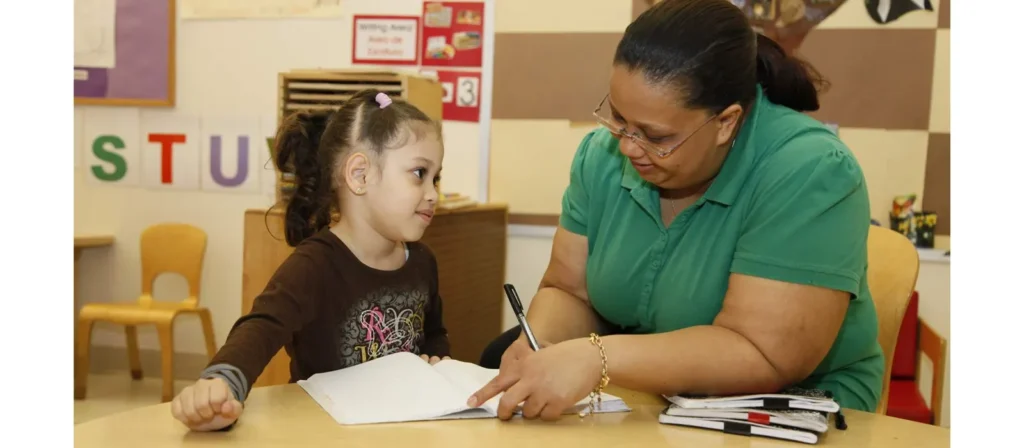
8. Tools: Formal vs Informal Assessment
- Formal Assessment:
Common tools include standardized tests, structured diagnostic assessments, formal screeners, and performance-based tasks with clear scoring rubrics. These tools are often selected for their validity, reliability, and alignment with established standards. - Informal Assessment:
The tools are more varied and context-driven, ranging from observation checklists and anecdotal records to work samples, portfolios, and teacher-made tasks. These resources allow educators to capture learning as it unfolds during play, group discussions, or everyday routines.
9. Data Use: Formal vs Informal Assessment
- Formal Assessment:
The data generated from formal assessments is typically used for administrative or institutional purposes. Schools may rely on this data to evaluate curriculum effectiveness, track student achievement trends, or determine placement in special education programs. Because the results are standardized, they can be aggregated and compared across classes, schools, or even districts. This makes formal data especially useful for policy decisions and long-term planning. - Informal Assessment:
Teachers primarily use data from informal assessments to guide day-to-day instruction and support individualized learning. Notes, checklists, and work samples provide context-rich insights into each child’s unique progress. While not often used for formal reporting, this type of data is invaluable for parent-teacher conferences, reflective teaching practices, and personalized support strategies. It ensures that teaching stays responsive and relevant to each child’s evolving needs.
Why is it Important to Distinguish Between Formal and Informal assessments?
In early childhood education, the ability to differentiate between formal vs informal assessment is not merely an academic exercise—it’s a critical competency that impacts every aspect of teaching and learning. Educators, parents, and policymakers all benefit from understanding the unique contributions and limitations of each type of assessment.

Tailoring Instruction to Meet Individual Needs
When teachers recognize the differences between formal and informal assessments, they can better tailor their instructional approaches. Formal tools offer concrete data that help identify specific skill gaps, while informal methods capture nuances of learning styles, social development, and emotional well-being. Understanding this distinction allows educators to craft a more individualized and responsive สภาพแวดล้อมการเรียนรู้.
Enhancing the Accuracy of Developmental Insights
Each assessment type provides a different lens through which to view a child’s development. Relying solely on one approach may result in an incomplete or skewed perspective. By distinguishing between formal vs informal assessment, educators can triangulate data from multiple sources, resulting in a more accurate and comprehensive understanding of a child’s progress.
Supporting Holistic Development
Formal assessments often focus on academic outcomes, while informal assessments are more adept at capturing social-emotional growth, problem-solving abilities, and interpersonal skills. Knowing when to use which type ensures that no aspect of a child’s development is overlooked, promoting a well-rounded educational experience.
Facilitating Better Communication with Families
Parents and caregivers often struggle to interpret formal test scores or understand technical assessment reports. On the other hand, informal assessments—such as anecdotal notes or portfolio samples—provide concrete examples of a child’s behavior and progress. When educators clearly understand and can explain the differences between formal vs informal assessment, they foster more meaningful and collaborative conversations with families.
Aligning Assessment with Educational Goals
Different educational objectives call for different assessment strategies. For example, evaluating readiness for kindergarten may require standardized testing, while assessing a child’s confidence in social settings might be better captured through informal observation. Distinguishing between the two enables educators to select the most appropriate tool for the goal at hand.
Avoiding Misinterpretation and Bias
Each assessment method carries potential biases—formal assessments may favor children from specific linguistic backgrounds, while a teacher’s subjective impressions can influence informal observations. Recognizing the inherent strengths and weaknesses of formal vs informal assessment reduces the likelihood of misinterpretation and ensures fairer, more equitable evaluations.
Complying with Policy and Reporting Requirements
Formal assessments are often required for institutional or government accountability, whereas informal assessments support daily instructional decisions. Being able to distinguish between them ensures that educators meet both bureaucratic obligations and the immediate needs of their students.
Similarities Between Formal and Informal Assessment
Although educators often highlight the contrasts in the formal vs informal assessment discussion, it’s equally important to recognize the shared purposes and functions that unite both approaches. Despite their differences in format and execution, formal and informal assessments have several core similarities that contribute to effective early childhood education.
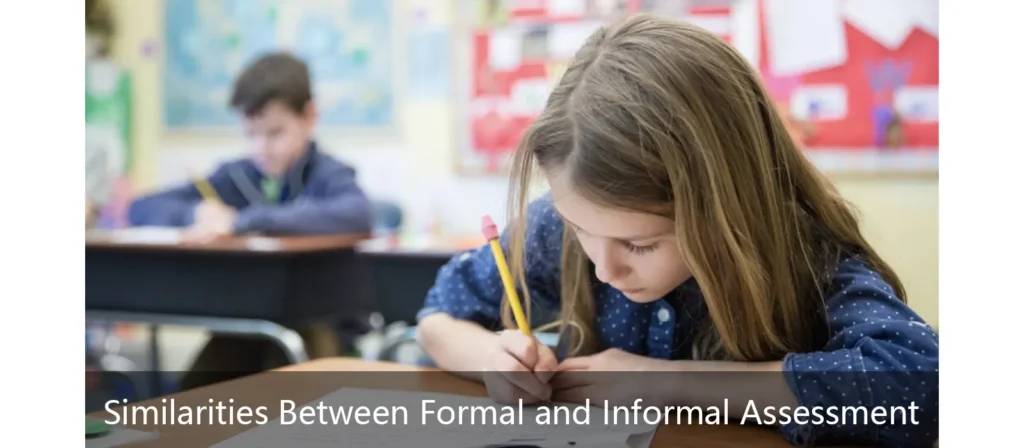
- Both Aim to Support Learning and Development
At their heart, both formal and informal assessments are tools to understand and enhance a child’s learning journey. Whether through structured tests or casual observations, the ultimate goal remains the same: to gather information that can inform teaching strategies and promote developmentally appropriate practices. - Used for Monitoring Progress
Formal and informal assessments help educators track a child’s growth over time. Both can reveal strengths and areas for improvement, identify learning trends, and support decisions about future instruction. This shared goal makes them essential in planning individualized learning experiences and ensuring that each child is progressing at their own pace. - Contribute to Instructional Decision-Making
Effective teachers use insights from both assessment types to adapt their teaching. Whether it’s a reading score from a formal test or a noted improvement in peer interaction observed informally, both forms of assessment provide valuable feedback that can shape daily instruction and long-term planning. - Encourage Reflective Practice
Assessment, whether formal or informal, encourages educators to reflect on their methods, classroom environment, and interactions with children. Teachers can identify what strategies are working and which ones need adjustment. This reflective practice enhances the overall quality of education provided. - Can Be Shared with Stakeholders
Both types of assessments serve as communication tools between educators, parents, and administrators. They help explain a child’s learning profile, outline developmental milestones, and support collaborative decision-making. By using both types of assessments, teachers can offer a well-rounded picture to stakeholders. - Require Professional Judgment
Although formal assessments may appear more objective due to their structured format, interpreting results from either assessment type demands professional expertise. Educators must consider context, individual variability, and environmental factors to make accurate and meaningful conclusions from the data gathered.
ค้นพบผลิตภัณฑ์ทั้งหมดของเรา
เข้าถึงแค็ตตาล็อกที่ครอบคลุมของเราซึ่งมีเฟอร์นิเจอร์คุณภาพเยี่ยมและอุปกรณ์การเล่นสำหรับโรงเรียนอนุบาลและโรงเรียน
Strategies for Integrating Formal and Informal Assessment
Integrating formal and informal assessments empowers educators to move beyond isolated data points and see the whole child. It supports developmentally appropriate practices and ensures that all children, regardless of background or learning style, receive the recognition, support, and opportunities they need to thrive.
1. Creating a Balanced Assessment Framework
The first step in integration is developing a structured plan that combines both assessment types purposefully. This means scheduling formal periodic evaluations, such as developmental screenings or literacy benchmarks, alongside continuous informal observations, journals, and work samples. Together, they form a dynamic loop of data collection, interpretation, and instructional planning.
2. Using Informal Observations to Interpret Formal Results
Formal tests may indicate that a child struggles with verbal reasoning, but informal observations might reveal that the child is shy or only communicates comfortably with familiar adults. Educators can use informal data to understand the context behind test scores, ensuring that decisions are both data-driven and child-centered.
3. Planning Instruction Based on Combined Data
Teachers can analyze formal results to identify general trends or needs in the classroom and then observe students informally to tailor specific activities. For instance, if a test reveals low early math skills across a group, the teacher might observe how children engage with counting during play to design developmentally appropriate math interventions.
4. Documenting Informal Assessment to Complement Formal Reports
Maintaining detailed records of informal assessments, such as anecdotal notes, photographs, or portfolios, can enhance the depth of formal reports. When shared with families or support staff, this documentation offers a more vivid and personalized account of a child’s learning journey.
5. Aligning Assessments with Learning Goals
Educators should ensure both formal and informal assessments are linked to the same developmental and curricular objectives. For example, if the goal is to improve early literacy, formal reading tests can be supported by informal observations of storybook engagement or emergent writing samples. This alignment ensures consistency in evaluating and supporting growth.
6. Fostering Team Collaboration
Integrating formal vs informal assessment also means encouraging collaborative analysis. Teachers, support staff, and specialists can meet regularly to compare assessment results, cross-validate findings, and design coordinated intervention plans. This multidisciplinary approach helps prevent gaps in understanding and response.
7. Training and Professional Development
Successful integration requires teachers to be well-versed in both assessment types. Ongoing professional development should include training in administering formal tools, documenting informal observations, and interpreting combined results effectively. Teachers who are confident in both domains can better support diverse learners and make informed instructional decisions.
8. Using Technology to Combine Data
Digital platforms can help educators merge and analyze data from various sources. For instance, assessment apps may allow teachers to input formal test results alongside observational notes and media. This centralized system streamlines analysis, reporting, and sharing with parents or administrators.
9. Engaging Families with Integrated Reports
When presenting assessment results to families, combining quantitative (formal) data with qualitative (informal) insights makes the report more comprehensive and understandable. For instance, a report might pair a reading score with a teacher’s notes on the child’s enthusiasm for story time, creating a richer narrative of progress.
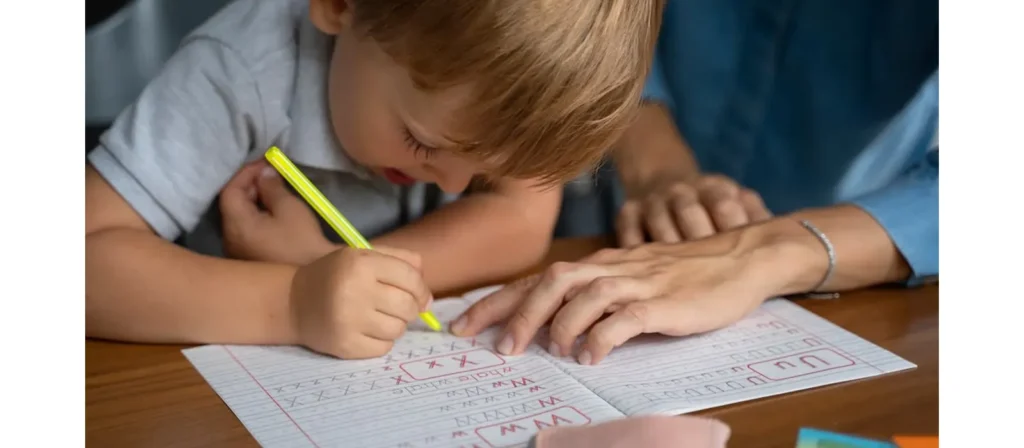
Common Misconceptions About Formal and Informal Assessment
Despite the central role that assessments play in early childhood education, there are still widespread misunderstandings about both formal and informal methods. These misconceptions can lead to ineffective assessment practices, misinterpretation of children’s abilities, or misplaced instructional priorities. Clarifying these myths helps educators and parents make more informed decisions in the formal vs informal assessment landscape.
Misconception 1: Formal Assessments Are Always More Accurate
Many people assume that standardized tests and structured tools automatically yield more reliable results. While formal assessments do offer consistency and benchmarks, they can be influenced by test anxiety, unfamiliar environments, or cultural biases. Informal assessments, on the other hand, provide real-life insights that often reveal abilities missed in test settings.
Misconception 2: Informal Assessment Is Just “Watching”
A common myth is that informal assessment lacks rigor and is nothing more than casual observation. In reality, quality informal assessments are systematic, intentional, and guided by clear developmental goals. They require skilled observation, detailed documentation, and thoughtful interpretation.
Misconception 3: Only Formal Assessments Are Useful for Reporting
Some educators and administrators believe that only data from formal assessments is valid for progress reports or parent-teacher conferences. In truth, integrating informal insights—like work samples, teacher notes, and learning stories—creates a more complete and meaningful picture of a child’s development.
Misconception 4: Informal Assessments Are Too Subjective to Be Useful
While informal assessments do involve educator judgment, they are not inherently unreliable. When documented consistently and interpreted through a professional lens, informal data can be just as valid as formal test results, especially when cross-verified or supported by multiple observations.
Misconception 5: Formal and Informal Assessments Must Be Used Separately
Another widespread misunderstanding is that educators must choose between formal and informal assessments. In the formal vs informal assessment conversation, the best practice is not to choose one over the other, but to blend both to capture a full spectrum of learning and development.
Misconception 6: Formal Assessment Is Only for Older Children
There’s a belief that young children aren’t ready for structured evaluation. While it’s true that overly rigid testing can be inappropriate, there are developmentally appropriate formal assessments explicitly designed for early learners. These tools can be used effectively when balanced with informal methods.
Misconception 7: Informal Assessments Lack Educational Value
Some stakeholders mistakenly view informal assessment as secondary or supplemental. In reality, informal assessments can drive everyday instructional decisions, reveal learning preferences, and support emotional and social development—areas that formal assessments often overlook.
Misconception 8: All Formal Assessments Are High-Stakes
People often associate formal assessments with stress, labels, or gatekeeping (like entry tests or standardized exams). However, many formal assessments used in early education are low-stakes, formative, and intended to guide instruction, not judge performance.
Misconception 9: Informal Assessments Don’t Require Documentation
Even experienced educators can underestimate the importance of recording informal assessments. Without documentation, informal insights can be lost or misremembered. Thoughtful documentation transforms informal observations into actionable educational data.
FAQs About Formal Vs Informal Assessment
- What is the difference between formal and informal assessment?
Formal assessment refers to structured, standardized tools like tests and checklists, while informal assessment involves observational and anecdotal methods used in natural settings. Both aim to monitor and support a child’s development. - Can formal and informal assessments be used together?
Yes, integrating both provides a more complete picture of a child’s abilities. Formal assessments offer measurable benchmarks, while informal methods capture context, behavior, and daily learning progress. - Which is more accurate: a formal or an informal assessment?
Neither is inherently more accurate. Accuracy depends on how appropriately the method is used and interpreted. Formal assessments provide consistency, while informal assessments offer depth and context. - Are informal assessments valid for reporting to parents or administrators?
Absolutely. When documented systematically, informal assessments provide rich, personalized insights that complement formal data and support meaningful communication with families and stakeholders. - Do young children respond better to informal assessments?
Yes, many young children feel more comfortable in informal settings. Informal assessments reduce pressure and allow children to demonstrate their skills naturally during play or daily activities. - Is an informal assessment less time-consuming than a formal assessment?
Not necessarily. While informal assessment avoids structured testing, it requires ongoing observation, documentation, and reflection, which can be just as time-intensive. - Can formal assessments identify special needs in early childhood?
Yes, specific formal tools are designed to detect developmental delays or learning challenges. However, informal assessments often help identify early signs through behavioral cues and interaction patterns. - How often should teachers use formal assessments in early childhood settings?
Formal assessments should be used periodically, not constantly, and aligned with developmental milestones. Frequency depends on curriculum goals, program guidelines, and individual child needs. - Do informal assessments require special training?
Yes, informal assessment involves trained observation, proper documentation, and interpretation skills. Educators need to recognize developmental cues and patterns to use informal tools meaningfully.
บทสรุป
Formal assessments provide structure, consistency, and measurable outcomes that are essential for tracking progress, meeting standards, and identifying specific learning needs. Informal assessments, on the other hand, offer rich, real-time insights into a child’s everyday behaviors, emotions, creativity, and learning styles. Together, they form a powerful partnership.
Rather than viewing these methods as opposites, educators should embrace them as complementary strategies. By integrating both formal and informal assessments thoughtfully, teachers can paint a fuller, more authentic picture of each child’s development, ensuring that no strength goes unnoticed and no challenge unaddressed.
